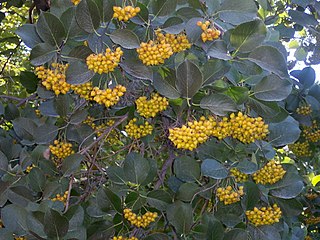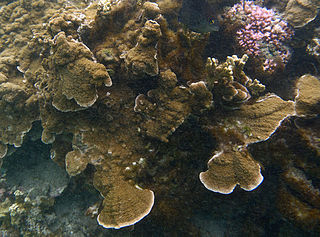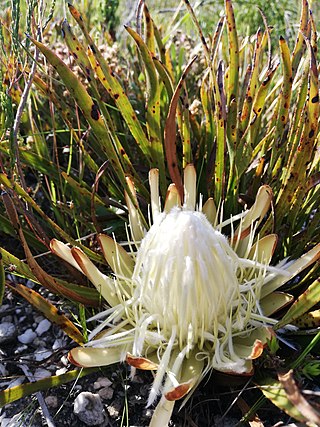
The International Union for Conservation of Nature (IUCN) Red List of Threatened Species, also known as the IUCN Red List or Red Data Book, founded in 1964, is an inventory of the global conservation status and extinction risk of biological species. A series of Regional Red Lists, which assess the risk of extinction to species within a political management unit, are also produced by countries and organizations.
Ormocarpopsis aspera is a species of flowering plant in the family Fabaceae. It is found only in Madagascar.
Scalesia aspera is a species of flowering plant in the family Asteraceae. It is found only in the Galapagos Islands of Ecuador. It is threatened by habitat loss.

Hylomantis aspera or the rough leaf frog is a species of frog in the subfamily Phyllomedusinae. It is endemic to Brazil. It has been seen as high as 600 meters above sea level.
The Derby toadlet is a species of frog in the family Myobatrachidae. It is endemic to the Kimberley region near Derby and Broome in Western Australia. Its natural habitats are subtropical or tropical dry lowland grassland and intermittent freshwater marshes.
Pipa aspera, the Albina Surinam toad, is a species of frog in the family Pipidae found in French Guiana, Suriname, and possibly Brazil. Its natural habitats are subtropical or tropical moist lowland forests, rivers, freshwater marshes, and intermittent freshwater marshes. The color of this species is a reddish-brown to a brownish-black, noticed on the dorsal part of its body. The weights of females range between 5 and 12 grams, and males between 4 and 7 grams, noting that females are usually significantly larger.
Trattinnickia aspera is a species of plant in the Burseraceae family. It is found in Colombia, Costa Rica, Ecuador, Nicaragua, Panama, Peru, and Bolivia.

Hydrangea aspera is a species of flowering plant in the family Hydrangeaceae native to dense forests in the region between the Himalayas, across southern China, to Taiwan. It is a large, erect deciduous shrub growing to 3 m (10 ft) tall and wide, with broadly oval leaves and dense branches. The flowers are typically borne in large flat heads in late summer, and are in variable shades of pale blue and pink, fringed by white or pale pink sterile florets.

Ehretia acuminata is a deciduous tree found in Japan, China, Bhutan, Nepal, Laos, Vietnam, New Guinea and Australia. Fossil evidence suggests an ancient Laurasian origin. This group of plants spread to Australia and South America via Africa, when these continents were still joined.

Ehretia is a genus of flowering plants in the borage family, Boraginaceae. It contains 66 species native to the tropics and subtropics of the Americas, sub-Saharan Africa, Asia, Papuasia, and Australia. The generic name honors German botanical illustrator Georg Dionysius Ehret (1708–1770).

Acanthemblemaria aspera, the roughhead blenny, is a species of blenny native to the tropical western Atlantic Ocean. Typical length is 19 mm (0.75 in) for adult males and 21 mm (0.83 in) for females.

Grevillea aspera, commonly known as the rough grevillea, is a species of flowering plant in the family Proteaceae and is endemic to Australia, occurring mainly in South Australia. It is low, spreading to erect shrub with oblong to egg-shaped leaves with the narrower end towards the base, and pinkish to red and cream-coloured, green, yellow or white flowers.

Ehretia saligna, commonly known as peach bush, native willow and peachwood is a species of shrubs or small trees, endemic to Northern Australia. The natural range extends from the Gascoyne, across the Northern Territory throughout northern Queensland and coastal; regions of Southern Queensland and New South Wales.

Acropora aspera is a species of staghorn coral in the family Acroporidae. It is found on reef flats and in lagoons in very shallow water in the western Indo-Pacific Ocean.

Ehretia dicksonii is a tree that is native to Asia and cultivated as an ornamental plant.

Echinophyllia aspera, commonly known as the Chalice coral, is a species of large polyp stony corals in the family Lobophylliidae. It is a colonial coral which is partly encrusting and partly forms laminate plates or tiers. It is native to the western and central Indo-Pacific.

Ephedra coryi, also known as Cory's joint-fir, is a rare, reed-like gymnosperm native to sandy, semi-arid areas of the North American South and Southwest.

Protea aspera, commonly known as rough leaf sugar bush or aardroos suikerbos, is a flowering shrub that belongs to the well-known Protea genus. The plant is endemic to South Africa and is found in the Kleinrivierberge, Bredasdorpberge and Garcia's Pass.

Tibouchina aspera is a species of flowering plant in the family Melastomataceae, native to Central America and tropical South America. It was first described by Jean Fusée Aublet in 1775. In the original description of the species, it was suggested that the plant was inhaled to treat chest pain and dry coughs.















